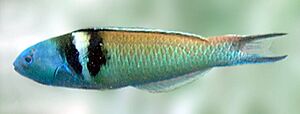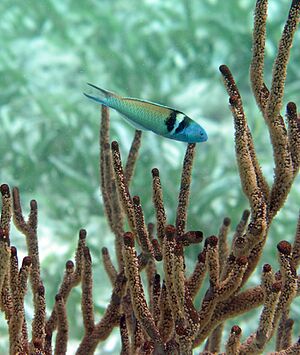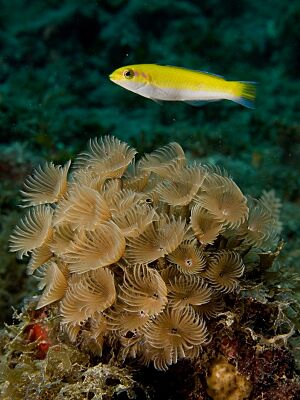Bluehead facts for kids
Quick facts for kids Bluehead |
|
|---|---|
 |
|
| Conservation status | |
| Scientific classification | |
| Synonyms | |
|
The blue-headed wrasse (scientific name: Thalassoma bifasciatum) is a small, colorful fish. It lives in the warm, tropical waters of the western Atlantic Ocean. You can find these fish swimming around coral reefs. They are a type of ray-finned fish, which means their fins are supported by bony rays. Blue-headed wrasses are part of the Labridae family, also known as the wrasse family.
These fish are quite small, usually less than 110 millimeters (about 4 inches) long. They do not live very long, often less than two years. Blue-headed wrasses often swim together in large groups called schools. They are very important "cleaner fish" on the reefs. This means they help other fish by eating tiny parasites off their bodies.
Contents
Where Do Blue-Headed Wrasses Live?
The blue-headed wrasse lives in the Atlantic Ocean. You can find them mainly in the Caribbean Sea. They also live in the southeastern part of the Gulf of Mexico. These fish prefer to live in coral reefs.
What Do Blue-Headed Wrasses Look Like?
Blue-headed wrasses can change their colors as they grow. Young fish, both male and female, have yellow upper bodies. Their lower bodies are white. They might also have green or black stripes along their sides. Sometimes, they have dark bars going up and down their bodies. This look is called the "initial phase."
These fish can quickly change how bright their yellow color is. They can also change how strong their stripes and bars look. These color changes often show how the fish is behaving.
Color Changes and Growth
Older females and some males can change their colors permanently. They can also change their sex! When they do this, they enter the "terminal phase." In this phase, they have a bright blue head. They also have black and white bars right behind their head. The rest of their body is green. This blue head is how the fish got its name.
Terminal phase males are usually bigger than initial phase males. They are about 70 to 80 millimeters long. Initial phase males are around 60 millimeters long.
What Do Blue-Headed Wrasses Eat?
Blue-headed wrasses are busy eaters. They search for many different kinds of food.
- They eat tiny animals that float in the water, called zooplankton.
- They also eat small mollusks and tiny crustaceans. These include small shrimp and krill.
- Worms and other small moving invertebrates are also on their menu.
- Sometimes, they eat the eggs of smaller fish.
- As "cleaner fish," they also eat tiny parasites from other fish.
Younger males mostly eat zooplankton that floats by in the ocean currents. Females and young males have specific times during the day when they hunt for food.
Who Eats Blue-Headed Wrasses?
Even though blue-headed wrasses clean other fish, some bigger fish still see them as food. They avoid cleaning large fish that eat other fish, called piscivores. Examples of these predators include the spotted moray eel, the graysby, and the red hind. These fish might eat a blue-headed wrasse. However, they usually do not eat other cleaner fish like gobies. Other animals that hunt blue-headed wrasses include the greater soapfish, the roughtail stingray, and the trumpetfish.
How Are Blue-Headed Wrasses Doing?
The blue-headed wrasse is a very common fish. It is found all over the northwestern Atlantic. It is one of the most common fish on coral reefs near Puerto Rico, the Virgin Islands, and the Netherlands Antilles. Because there are so many of them, they are listed as a species of "Least Concern." This means they are not currently in danger of disappearing.
However, these fish tend to stay in one area. If their coral reef homes are destroyed, it could cause problems for local groups of wrasses. People sometimes collect these fish for home aquariums because they are so colorful. But this is not a big threat to the species as a whole.
How Do Blue-Headed Wrasses Behave?
Like many other wrasse species, the blue-headed wrasse is a protogynous sequential hermaphrodite. This is a fancy way of saying that individuals can start their lives as either male or female. But females can change their sex later in life and become males.
Social Life of Males
Male blue-headed wrasses have a special social system.
- Terminal phase males are the most aggressive. They are like the "top dogs" among the males.
- Initial phase males try to mate whenever they get a chance within a larger group.
The color changes of a blue-headed wrasse can show what it is trying to do. When a terminal phase male chases an initial phase male, its color changes to a shiny metallic green. But when a terminal phase male is trying to attract a female, it turns pink or grey. It also forms black circles on its fins.
Sex Change in Blue-Headed Wrasses
Both initial phase females and initial phase males can change into terminal phase males. This change can happen quite quickly, sometimes in about 8 days. Once a fish changes into a terminal phase male, it cannot change back. This change is permanent.
Mating and Reproduction
Large terminal phase males protect special breeding spots. Females travel to these spots every day to mate. Studies have shown that females play a very important role in choosing where these mating spots are. If females are replaced in a group, new mating spots often appear. This shows that males will go to the spots that females prefer.
Blue-headed wrasses do not have fixed territories. Their groups move around freely. Females usually stay in their original spawning (egg-laying) spots. Males, however, are known to move away or be taken away. Females might stay because they are used to those areas. Also, staying in a familiar spot might help them avoid predators.
In some very large coral reefs, many blue-headed wrasses gather daily to mate in one specific area. Studies have shown that fish often stay loyal to their feeding schools. These schools are spread out across the reef. However, the fish will travel long distances, sometimes over 1.5 kilometers (almost a mile), to reach the special mating grounds. Even with these long travels, females that live far away from the mating spot lay just as many eggs as those who live closer. This suggests that getting enough food might be more important than the cost of a long journey to mate.
Images for kids




